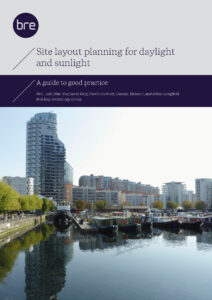NEW BRE GUIDELINES ON DAYLIGHT AND SUNLIGHT PUBLISHED
The long anticipated revised version of the BRE guidelines on daylight and sunlight has now been published. ‘Site Layout Planning for Daylight and Sunlight: a guide to good practice’ (BRE209 2022) replaces the previous edition issued back in 2011.

No Significant Alterations to the Assessment of Impact on Neighbours
There are no significant changes to the methodology or the target criteria for the assessment of the impact of a proposed scheme on neighbouring properties, although there are some minor amendments and clarifications.
Further guidance in respect of Passive Solar Design, Glare and Solar Convergence is also updated.
Radical Alteration to the Assessment of Daylight and Sunlight Within New Developments
The principal change relates to the assessment of daylight within new schemes:
- BS8206-2 is obsolete and therefore so is the associated Average Daylight Factor (ADF) methodology.
- Instead, BS EN 17037 is referenced, which uses a Climate Based Daylight Modelling (CBDM) methodology and/or daylight factor targets (but the latter is not the same as ADF)
The old ADF methodology was based on a simplistic assumption that natural light from the sky is constant throughout each day and throughout the year and was independent of the orientation of the building.
Of course, in reality, the amount of daylight varies enormously depending on the time of day, the time of the year and the weather conditions. Also, a south facing room will be better lit than a north facing room.
The new methodology seeks to account for these factors using weather data and arguably provides a more realistic simulation of daylight throughout the year.
The assessments are, as a result, far more complex and involves calculating the daylight levels for each daylight hour on every day of the year. The results are then assessed against the new BRE recommended daylight targets.
In addition to internal daylight, the assessment methodology for testing sunlight levels within new development has also been revised. Instead of the previous Annual Probable Sunlight Hours (APSH) method, the test is now to receive a minimum of 1.5 hours of sunlight on March 21st.
Point2’s in-house Technical Department have developed and tested new software over the last few years and are fully geared up to efficiently provide comprehensive CBDM assessments of even the largest schemes.
Whilst the new guidelines are both complex and more onerous than the old ADF methodology, Point 2 have developed clear and intuitive ways of presenting the results and are experienced in advising on how to optimise the design to maximise compliance rates.
So what does this all mean for Developers?
In short, for most schemes it will now be more difficult to achieve internal daylight compliance levels, the pass rate on a like for like basis with the old methodology will in most cases reduce.
As we have been working on the new software in the background (we were consulted on the new guidance early last year) we are perfectly positioned to start adopting this new methodology straight away.
For us, the big question is how local planning authorities will take to this new guidance, although we are fully expecting a transition period where it may be beneficial to present both old and new calculations to help local authorities understand the implications.
The key will be familiarisation of the new guidance and how we can inform the design of new buildings to maximise daylight and sunlight against this new, arguably more stringent set of criteria.
If you would like any more information on the new Guidelines or indeed a focused CPD session that goes into more detail then please do not hesitate to get in touch.

